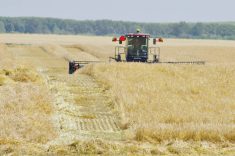CNSC / The U.S. Department of Agriculture surprised some analysts Wednesday by leaving seeded area estimates unchanged for all U.S. crops. Before the report, a poll of grain analysts by Reuters found expectations were for corn acres to drop 1.5 million acres and soybean acres to rise 700,000 due to seeding difficulties this spring.
Over the past five years USDA’s June WASDE (World Agricultural Supply and Demand Estimates) report was left unchanged four out of five times. The exception was 2011, when planting delays in early June in the eastern Corn Belt and northern Plains led to widespread reductions in sown area.
Read Also

Thunderstorms and straight-line winds
Straight-line winds in thunderstorms can cause as much damage as a tornado and are next on our weather school list exploring how and why severe summer weather forms.
The seeding pace for both corn and soybeans was the slowest since 1996, reflecting the excess moisture and cool temperatures. Many thought this would be reflected in cropped area.
USDA did lower expectations for U.S. corn production even though the sown and harvested areas were unchanged. The average yield slipped to 156.5 bushels per acre, down 1.5 bushels per acre from the previous month.
“Despite rapid planting progress during mid-May across the Corn Belt, rains and cool temperatures since have delayed the completion of planting in parts of the western Corn Belt and raised the likelihood that seasonally warmer temperatures and drier conditions in late July will adversely affect pollination and kernel set in a larger share of this year’s crop,” USDA reported.
Production estimates for other coarse grains (sorghum, barley and oats) were unchanged. Similarly, forecasted production of oilseeds (soybeans, canola and sunflower) was unchanged.
Winter wheat boosted
Only in winter wheat was the situation more optimistic, despite earlier concerns about the effect of poor weather last fall and winter. All classes showed increases in production forecasts. Hard red winter showed the greatest gains increasing 13 million bushels to 781 million bushels. Soft red winter wheat rose eight million bushels, while white wheat moved up two million.
The increase in yield expectations contrasts the comments in the crop production report, also released Wednesday. In that report, USDA cited “unseasonably cool early-month temperatures (which) limited crop development in many of the major winter wheat-producing states, leading to the slowest heading pace since 1993.”
Additionally, they described wheat producers in Texas baling for hay winter crops damaged by dry, windy or freezing conditions. Outside of the Great Plains, “fields in the Pacific Northwest were in need of additional moisture” the USDA said.
While the commentary paints a bleak picture, the yield numbers do not reflect them. Only in a handful of the driest states, such as Colorado, did yield estimates drop. Even in parched Texas yield estimates rose three bushels per acre.
Following the optimistic report for wheat, futures dropped across the Kansas and Chicago exchanges. Similarly the corn market traded lower on the Chicago Mercantile Exchange following the bearish report.
USDA’s next report will be released July 11.
The July report historically contains more yield and acreage revisions than the June report. Five out of five of the most recent USDA July reports have changed yield and acres, leading many market participants to await the July report to see the anticipated changes occur.
— Stuart McMillan writes from Winnipeg on weather and agronomic issues affecting Prairie farmers.


















